Lamps with a motion sensor: how they work, how to connect + TOP best manufacturers
Due to the constant improvement of lighting devices, new opportunities are emerging and their performance characteristics are improving.The result is lamps with motion sensors - convenient and economical devices.
This new product has gained a good reputation among consumers. In this article we will talk about the operating principle of such lamps, their design features, and also reveal the secrets of their installation.
The content of the article:
Purpose of the motion sensor
The sensor element is charged with the function of determining the fact of movement of any object within reach and controlling the lighting. The lamp itself has nothing to do with responding to certain circumstances, but after receiving a signal from the sensor, it turns on or off.
As soon as some action is detected in the coverage area, a preset function on the relay is activated. Not only the “turn on” command can be given, but also a signal to change a parameter such as power. For a light bulb with a motion sensor and dimmer It is possible to adjust the illumination indicators according to the time of day.
The interaction of the sensor, dimmer and lamp, as well as the time delay for turning on, depend on the previously programmed system settings.The last action is the activation of a command to activate the lamp after a set period of time, as a result of which it becomes possible to save energy.
Lamps supplemented with a built-in motion sensor are most often installed in residential premises, offices, and entrances. They are also used for smart outdoor lighting.
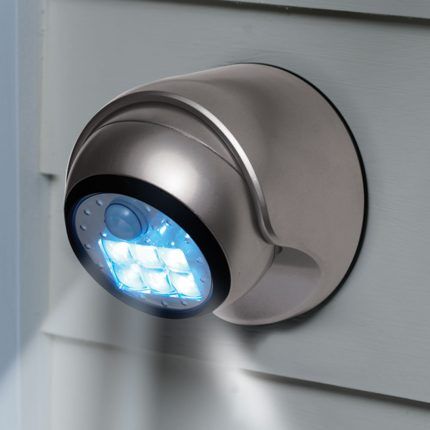
A person, due to his characteristic inattention, can leave the light on, and this results in additional expenses. A light that turns on after the room is empty simply solves this problem.
Types of lamps with motion detector
Depending on how the energy carrier is used, lamps can be:
- Stationary. They only function when connected to the network. They cannot be installed anywhere.
- Portable. These are self-contained devices that run on replaceable batteries. The advantage is that there is no connection with wires, but there is a power limitation.
Not only the traditional power grid can be used as an energy supplier. There are lamps equipped with solar batteries and a rechargeable battery. Only LED lamps can work with such power supply, because... they need a minimum of electricity.
According to the connection method, there are two options: in the first of them, the motion sensor is connected to the lamp using a wire and is called remote.
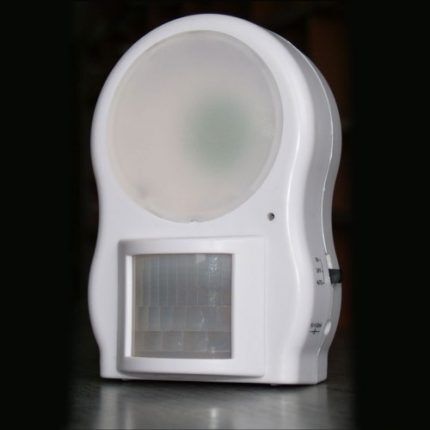
In the second, the sensor element and the lamp are a single structure; the sensor in this case is called built-in. The reading element can be either infrared or ultrasonic, based on microwave radiation.
Lamp with infrared detector
The most popular are devices supplemented with infrared detectors. They are activated when thermal characteristics change in the control zone. Such IR sensors are classified as passive. These devices have a large capture angle, high-precision settings, and safe radiation.
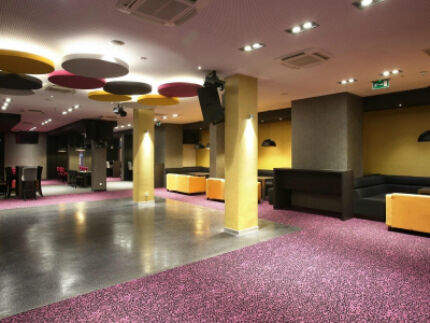
Lamps with passive IR detectors are intended for indoor use only. Their use for lighting courtyards and streets is impossible due to poor resistance to temperature changes. They take them out of action.
Ultrasonic and microwave options
These types of motion sensors are classified as active based on their operating principle. They have a common operating principle - emitting and receiving waves of a specific length. Lamps with sensors that respond to ultrasonic frequencies are universal. They are not afraid of atmospheric influences, so they are suitable for installation both inside and outside the house.
But ultrasonic sensors have disadvantages, and the main one is the negative impact on animals that can detect radiation. Added to this is a limited coverage area and low accuracy.
Microwave-based sensors operate by propagating magnetoelectric waves at frequencies greater than 5 GHz.They equip lamps installed in utility and industrial premises. Here their action is designed to pass through partitions and walls.
Expensive lamp models with motion-sensitive sensors are equipped with control panels. Their design includes several reading devices that control and, to some extent, overlap each other’s zones of influence.
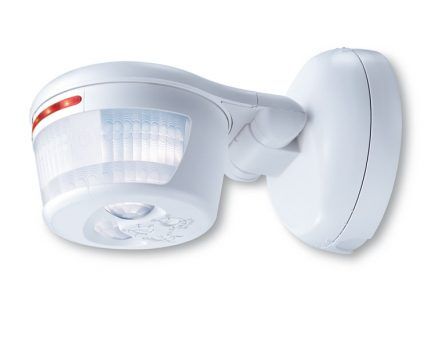
Lamps with sensors are designed to be powered from a source generating alternating current with a voltage of 220 V. The maximum power is up to 2 kW, although there are devices operating from 12 V.
Lamp design features
The difference between a light bulb with a motion sensor and the most ordinary one is the presence of a responsive element. The shell is made in the form of a lantern, floor lamp, chandelier or shade. Paired with a motion detector, different types of lamps are used: LED, fluorescent, halogen.
The most successful is a tandem with LED lamp. These functional devices are compact and easy to install. LED models are sometimes additionally equipped with an independent control relay or controller. Thanks to the presence of these options, you can control both the brightness and glow parameters.
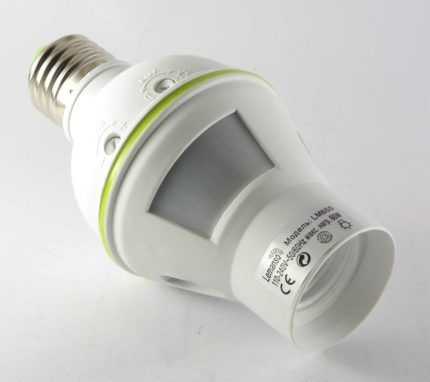
In some cases, protective systems are included in the circuit to protect against short circuits, temperature overloads, and high voltages.Regardless of the internal configuration, the operating principle of such lamps is unchanged: the lighting device must have a reading element - a sensor.
Advantages and disadvantages of lamps with motion detectors
A lamp with an electronic eye has many advantages. These devices are very convenient - when the system switches to automatic mode, there is no need for manual control.
Another advantage is the versatility of the lamps. They can be equipped with any type of light element, from a simple incandescent lamp to the most modern and economical light bulb.
Manufacturers produce these devices in a wide range of sizes. Since they only work periodically, they have a long service life. Lamps can be very decorative, so they are often used in landscaping.
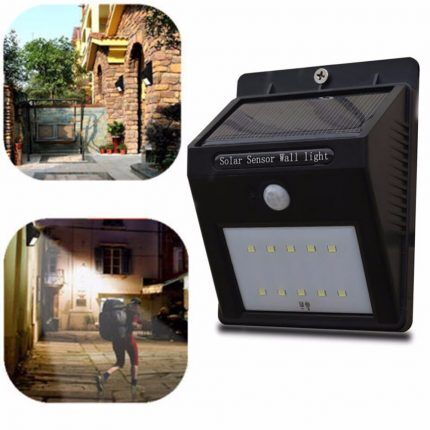
An alarm system can be connected to a lamp with a motion sensor. Such an alliance will help protect the yard from robbers. A good solution is a lamp with a beam configured according to all the rules and placed above the front door or in a dark garage. But the main advantage is considered to be the efficiency of these lighting devices. They save from 50 to 70% of electricity.
The disadvantages include two features of such lamps. The first is that the sensor is not able to detect movement that is perpendicular to it. Secondly, such a device is of little use for a room where people stay for a long time.
Features of lamp installation
To connect a lamp supplemented with a sensor, all circuits used for simple motion detector. There are three types of such schemes.
The first is a parallel connection of the device with a switch. In this situation, the lighting is turned on both due to the detection of a moving object in the controlled area, and through a switch.
The second is a serial connection of the sensor and switch. With this type of connection, the lamp can function only after closing the circuit by turning on the switch.
The third is a combined connection. After detecting movement in the controlled area, additional lighting is activated using a sensor.
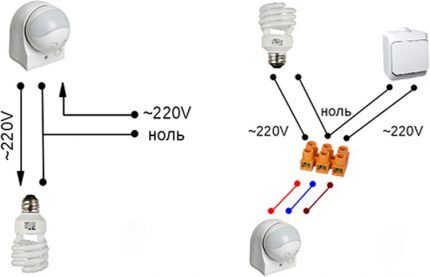
The position of the switch has no effect on this. The main lighting source is turned on by a switch.
Installation of a lighting device with a motion sensor
Let's consider the process using the example of a lamp intended for indoor installation. Due to its design, it is suitable for both ceiling and wall mounting. The housing contains a regular lamp, an ultrasonic HF motion sensor, and a light sensor.
The installation technology is simple and consists of six steps:
- At the first stage, the device is prepared for installation. The kit usually includes rubber seals. They are inserted into special holes designed for cable entry.
- De-energize the installation site by turning off the circuit breaker on the panel.
- The power cable is pulled through the seal into the lamp body. If there is excess length, shorten it.
- The housing is secured to the wall or ceiling through the holes provided for fastening.
- From the power cable remove the braid. If the housing material is dielectric, grounding is not required. Only the “zero” and “phase” wires are used, having previously removed the insulation from their ends - about 7 mm.
- Connect the wires to the appropriate terminals and secure them using a screwdriver. The phase wire is inserted into terminal L, and the neutral wire into terminal N.
The blank terminal, indicated by the symbol L with a prime, will remain unused. It is control and can be used to connect other lamps, ventilation or other equipment.

The only limitation is the power consumed by these devices. It should not exceed the additional connected load specified in the passport.
To determine which wire is phase, neutral and ground, you need to have the ability to read color coding. Both here and in Europe there is one standard - IEC 60446 2004.
According to this document, the color blue, or sometimes blue-white, indicates working zero. The ground wire is yellow-green in color. To mark the phase, the remaining colors are used - brown, black, red, white, and others.
If there is old wiring, the colors may not match the standard. Here, to determine whether they belong to a specific type, you will have to use a digital multimeter, an indicator screwdriver or a test light.
Connecting a lamp with a remote sensor
Installing a light bulb with a remote motion sensor has its own characteristics.
First, install the detector:
- Determine the installation location that provides the best viewing angle.
- The stand, previously removed from the device, is attached to the wall at a height of at least 240 cm.
- Clean the ends of the voltage wires connected to the sensor by removing about 1 cm of insulation from them.
- Open the cover of the sensor terminal box. There are multi-colored wires inside it.
- 220 V is supplied to the sensor by connecting the neutral and phase wires to the voltage.
Finally, the connection points are isolated. Next, proceed to connecting the light bulb and sensor. A phase is connected to one end of the lamp and insulated. The other end is connected to the neutral wire.
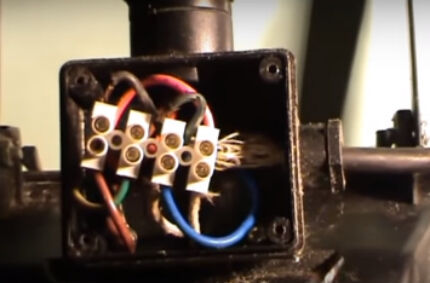
If the phasing is accidentally reversed during the connection process, the device will not work, but will remain in working condition. You just need to swap the wires. Using the same algorithm, it is possible to connect a wire with a plug to the detector.
The sensor itself is very easy to operate.
There are three regulators on its body that allow you to change the factory settings:
- SENS — sensor. It is used to set the sensitivity of the sensor. Such parameters are experimentally selected so that the device does not react to small animals.
- TIME — setting the lamp glow time.
- LUX — day-night adjustment. Set it so that the lamp turns on at dusk.
The response time can be adjusted in the range of 0.05 – 15 min.The sensor works most effectively at a capture angle of 120 to 360 degrees, over an area of about 20 m.

When determining the height and angle of inclination, it should be taken into account that some infrared sensors may have a dead zone. If the device has a fixed body and there is no positioning correction, it must be placed in accordance with the technical data sheet.
Recommendations from experts regarding installation
Experts do not recommend installing lamps with motion sensors in corners. The reason is a reduction in the viewing area.
Malfunctions and false alarms can also occur if such a lighting device is installed near air conditioners, radiators, and heat fans. Sometimes the lamp can turn on even when the blades of a room fan rotate, due to branches swaying outside the window.
When installing lamps with sensors within an apartment, experts advise placing them in the center of the ceiling. This is the optimal solution to the problem of detecting an object at the required time and at a specified distance.

Installing lamps with sensors outside involves taking into account individual moments. This is the openness of the panorama, detection angle, cross-country ability, permissible load, distance to enclosing structures. Due to insufficient cross-country ability, several sensors are sometimes installed.
Top best manufacturers of lamps with sensors
One of the first in this segment of the lighting market was a manufacturer from China. Feron. Such models of this brand as AL-559 and FN1200 are known. Their main advantage is a powerful luminous flux.
High-quality LED lamps equipped with motion sensors are produced by a German company Steinel. These are reliable modified models of lamps with infrared motion sensors RS 16L, RS LED D1.
LED lamps with such a sensor, produced by the Polish manufacturer Kanlux, are popular.
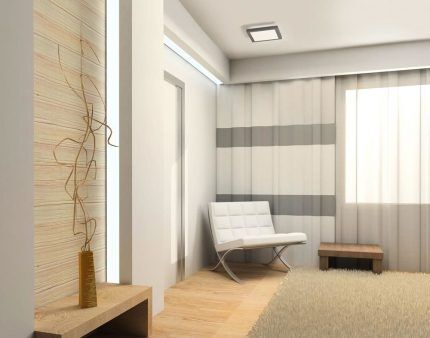
Company from Germany Euroelectric produces excellent lamps with sensors. We know the ST line of lamps from this manufacturer. Thus, model ST-69-2 is a good option for mounting on the wall of a house. It operates in a wide temperature range - from -20 °C to +40.
The Hardt company (Poland) supplies the market with special lamps with sensors for housing and communal services in a moisture- and dust-proof design. Wall light fixture Led-Hardt, equipped with an LED lamp, is highly impact resistant.
Excellent lamps for lighting home areas, parking lots, and billboards are produced by the manufacturer Delux. Here they produce LED spotlights with motion sensors, both narrow-beam and floodlight, with a degree of protection IP65.
An example of a good universal battery-powered mini-lamp is the model Mighty Light, released in China. It has a photo sensor and a built-in motion sensor. Equipped with a waterproof housing. The lamp installation method is wireless.
Conclusions and useful video on the topic
A thorough review of the Xiaomi MiJIA night lamp equipped with a motion sensor:
About installation of motion sensors according to all rules. Devices with such sensors are installed according to an identical scheme:
Both manufacturers and specialists, when talking about the advantages of lamps with a motion sensor, place the main emphasis on their efficiency. For them to really be like this, they need to be properly installed and configured. The conditions of use and protection class of the lamp are also important.
If you have experience using lamps with a motion sensor, please tell us which manufacturer's equipment you prefer. Are you satisfied with his work? Leave your comments and ask questions about the topic of the article in the block below.




I want to put these lamps in the entrance. I think this will significantly save general house electricity consumption. But which ones are better? Considering the Siberian climate, the entrance is something between a street and a house (from a temperature point of view), the average price is of interest, because with a high cost and unsatisfactory service life, this may be impractical. How do you think?
I thought that for a long time all entrances were equipped with lamps with motion sensors. We've had it like this for 10 years now. I won’t say for sure what type of motion sensor it is, but it seems like it’s infrared. Which, based on temperature fluctuations, determines whether there is someone in the entrance or not. As far as I know, they are also the cheapest in price. Bet it will pay for itself very quickly through energy savings.
Good afternoon, Valentin.The author of the article highlighted the topic of top brands that produce the products you require in a separate section. Lamps with motion sensors produced by the German company EUROELECTRIC are highly reliable. By typing “Euroelectric motion sensors for entrances” in Yandex, you will be taken to the desired brand page.
I came across a “Lamp Motion Sensor” that operates at temperatures of “-20~+40” degrees. Warranty - one year. Among the results you will find “luminaires with sensors for housing and communal services” - also manufactured by Euroelectric, the characteristics are similar, but there is a three-year guarantee. The prices of the mentioned models are 1300 rubles.
In general, a motion sensor is a useful thing, but somehow I had no luck with them. First, it broke down in one apartment for no reason, then in another. Moreover, when replacing it with direct connection, everything worked more than well. I still don’t understand what could be wrong.
We installed a video camera at the entrance to the entrance (a private house with 4 apartments) and nearby we replaced the regular lamp with a new one, with a sensor, which lights up on its own. But something in this lamp causes the camera to send alarm messages every ten minutes even if there is no movement.
I think that the lamp emits some kind of impulses that the camera catches and sends an alarm to us on the tablet. Because when there was only a camera and an ordinary lamp, this did not happen. And the alarm was called "Motion Detection", and now the alarm is called "Infrared Alert".
What could be the reason?
Good day, Elena. To clarify the situation with the relative position of the camera and sensor, I have attached a screenshot. Of course, the devices depicted there are named conventionally.
Now to the point - some models of motion sensors have infrared emitters and receivers of reflected IR radiation. The active element (emitter) increases the reliability of the device. I think this is exactly what you installed. Its IR radiation hitting the camera initiates an alarm.
The problem can be solved simply - mount a compact visor that blocks the beam from the sensor to the camera or move the sensor lower so that the IR beam does not fall on the camera.